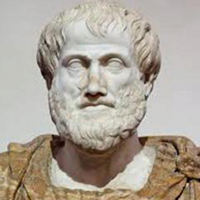Components of Tragedy in Aristotle's Poetics
Aristotle's theory of tragedy is completely based on induction. The ample examples or citations that Aristotle uses in his text from the tragedies of Sophocles, Aeschylus and Euripides, make the idea clear that his theory of this literary genre comes from his extensive reading of their tragedies, and the ideas are mere generalizations of the commonalities in their tragedies.

Aristotle (384-322 BC)
Thus, it is interesting to see a theory that followed the genre for which it is actually theorized. But in modern times this theory has lost its importance with the development of different sorts of tragic plots ending with a catastrophe. Now its significance is limited to the level of differentiating Aristotelian mode of tragedy from non-Aristotelian mode.
Aristotle defines tragedy as "the imitation of an action that is serious and having magnitude, complete in itself" in the medium of poetic language and the manner of dramatic presentation which incorporates "incidents arousing pity and fear, wherewith to accomplish catharsis of such emotions". An undeniable fact associated with this cathartic effect is that tragic representation of suffering and terrific defeat leaves an audience, not depressed, but relieved or even exalted. This distinctive effect on the reader, "the pleasure of pity and fear", is a basic way to distinguish it from comic and other forms of dramatic representation. Moreover, Aristotle makes the pleasure of pity and fear a rule that governs the organization of the tragic plot and choice of tragic hero and sees that a dramatist's aim should always be how to achieve this end in his drama.
There are six major components in tragedy according to Aristotle. They are:
(a) Plot
(b) Character
(c) Thought
(d) Diction
(e) Song
(f) Spectacle
(a) Plot: Aristotle defines plot as the soul of tragedy and emphasizes much on its unity. He treats it as a unified artistic whole directed toward the intended effect, that is, pleasure of pity and fear and catharsis of such human emotions. Being a unified whole, a plot should have a proper beginning, a middle and an end in which every part supports the whole and none of the parts are non-functional. And being an imitation of an action, the plot should imitate single action. The inclusion of a series of actions simply because they happen to a single character does not make an artistic whole.
In the plot, the events develop through complication to catastrophe. The "hamartia" or a severe tragic flaw of the protagonist leads to the complication and a sudden revelation, or "anagnorisis", of this flaw intensifies the complication and it in turn anticipates the tragic end of the character, or catastrophe after a sudden reversal in the fortune of the character, that is, "peripeteia". In this way, the plot moves from hamartia through anagnorisis and peripetiea to catastrophe. This shows that Aristotle favors the complex plot as opposed to the simple plot in which reversal of the situation is almost impossible.
(b) Character: It has a secondary place after the plot. By character, Aristotle means the tragic hero who is always a noble man who in turn is neither thoroughly good nor thoroughly evil but a mixture of both. He is always higher than the ordinary moral worth. If, according to Aristotle, the character is better-than-we-are, the tragic effect will be stronger. The tragic and unfortunate end of such a character moves in us pity and fear. He moves in us to pity because his misfortune is greater than what he actually deserves from his hamartia. Likewise, he moves us to fear, for we think of what will happen to our lesser and fallible selves.
(c) Thought: It is a way of saying what is appropriate to a given circumstance or situation. There should be a proper relationship between thought and situation. For example, a grave situation always expects a grave thought and vice-versa.
(d) Diction: It refers to the expression of meaning in words, or it is a primary mode of imitating the action. Words are medium of representation, and bearer of tragic meaning and effect.
(e) Song: Song is taken to be chief among the embellishments used in tragedy. It particularly refers to the song sung by a group of people known as chorus. Or, in other words, it refers to what is generally known as choric commentary in tragedy. It includes analysis of the major events of past, present and what will happen in the future that intensify the dramatic effects. It narrates the major events that are not shown on stage.
(f) Spectacles: It means the scenes used in drama for the sake of emotional attraction of the audience. It heightens the emotional significance of an event in the drama. But this is the sole work of a stage machinist or manager to set the scene as described by the dramatist.
This theory of tragedy later developed through Castlevetro to neo-classical theorists like Cornellie in 16th and 17th centuries. But where Aristotle is descriptive in his own right, the neoclassical theorists developed it as a rule of tragedy with an addition of two other elements to make up three unities of drama assimilating Aristotle's emphasis upon the unity of action.
Browse by Question
Aristotle Study Center
 |
bachelorandmaster.com |